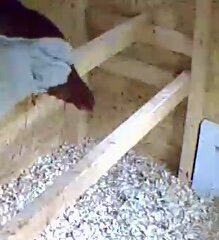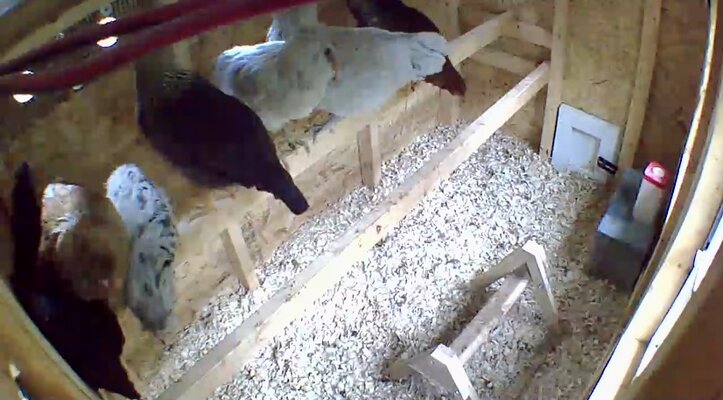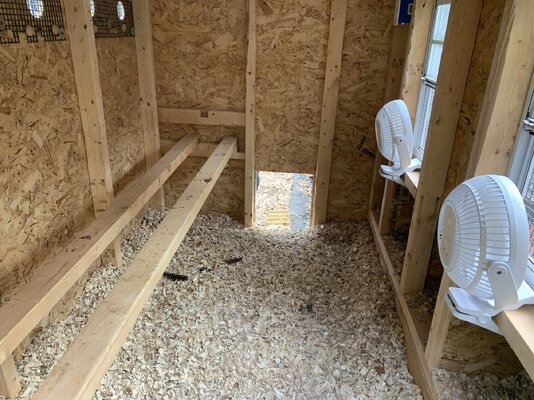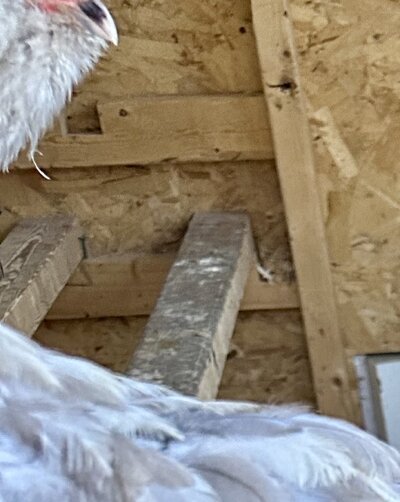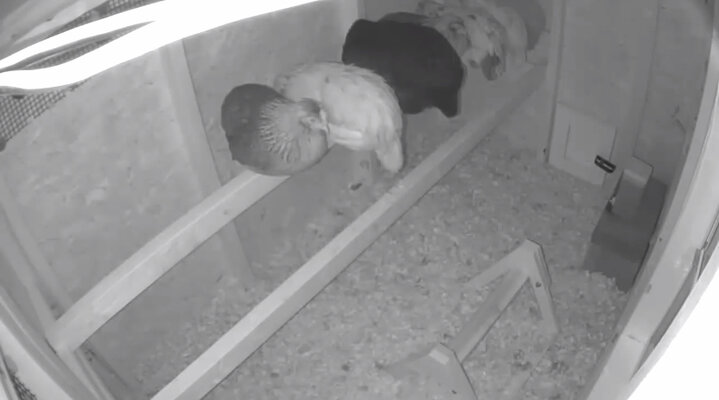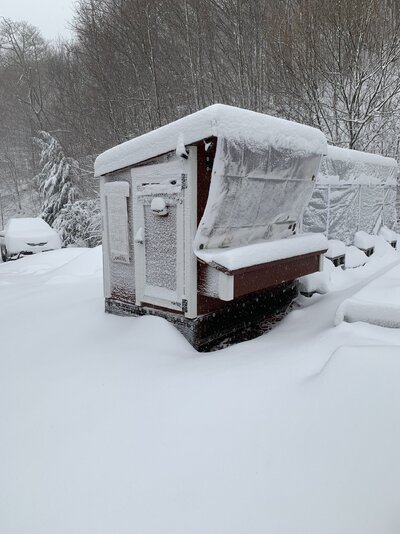MissGreenJeans
Songster
Hi, folks. I’ve got a challenging situation and would love your advice. My hens are about a year and a half old. They grew up together as chicks and have lived in harmony. A few months ago, they stated to molt for the first time. They didn’t do it all at once. The later molters are almost done now, I think, but they still look a bit rough. One, Dot, is near the bottom of the pecking order. Another, Towanda, is a more dominant bird.
About a week and a half ago, I came outside to let the girls out of their coop and into their run. I heard a horrible commotion—squawking like crazy. Dot came shooting out of the coop with Towanda in hot pursuit. They were distracted by me and breakfast, but I saw Towanda repeatedly go for Dot over the following days, and the attacks seemed pretty intense. It happened the same way in the morning again, so I got up when it was still dark to open the coop before they woke, thinking maybe they felt crowded in there, and I also wanted to provide an escape route for Dot. The behavior happened in the run, though, too, at different times of day. I didn’t see any blood, but Dot would flee, and Towanda would jump on top of her, pulling out feathers sometimes and always making Dot scream.
I didn’t intervene at first, thinking they might work it out, but it began to look like Towanda was really targeting Dot, who became more and more fearful, sometimes starting to panic and flee when she just saw Towanda across the run. This usually triggered an attack. It appeared to me that Dot was trying her best to avoid and defer to Towanda, but that didn’t make the aggression stop.
A few nights ago, the recent big freeze happened (thanks a lot, bomb cyclone), and I focused on prep for the plummeting temps. We went from lows in the 20s and 30s F to -10 on the worst night. The following cold day, the girls seemed pretty stressed. I took aart’s advice (thanks!) and provided electrolytes, which seemed to help. I also visited the run often to offer warm chicken chow mush and refresh frozen water. While out there, I constructed and set up a new visual barrier (a panel in the middle of the run) so that my two food and water stations were well separated and Dot had a place to hide.
I monitored the girls via camera and saw that they spent most of their time in the coop that day—except for Dot, who appeared to be too fearful to go into the coop with the rest of the hens. She spent almost the whole day alone, looking very cold and miserable in the run. I set up a heat panel for her and then kept making frequent visits. The other chickens would come out when I showed up. Dot would perk up at that point and eat offered treats, but Towanda continued to try and target her. During one visit, I noticed a little spot of dried blood on a different chicken—Camilla, another lower-ranking bird. As I started to inspect Camilla and look for a cause, Towanda approached and pecked her hard on the head, causing more bleeding. I saw then that Camilla’s comb looked like it had taken some recent hard pecks. Worried about Towanda terrorizing Dot and maybe others now, too, I removed Towanda from the flock. Unfortunately, I have no shed, basement or garage, and I only have the one coop and run, so I had to bring Towanda inside my house. She’s now alone in a room, in a dog crate with a solo set-up (perch, all the necessities, shavings, etc.).
Dot quickly seemed to recover and looked more confident once Towanda was gone. She even bossed around the lowest-ranking chicken a bit. All the girls slept soundly that night, snuggled up in the coop. They’ve now had two full days without Towanda.
I read a ton of great posts here about bullying and isolating the bully to knock her down a few pegs, putting “clutter” in the run (which I’ll add more of), and separating the victim instead of the bully (thanks, azygous!). Seems like I’ve got several potential options for next steps. My current plan is to use a modified dog ex-pen in the run to contain Towanda in a smaller, separate area. When I’ve set that up in a couple of days, the weather will warm up a bit (highs in the 50s, lows in the mid- to high 30s). I figure I’ll try to reintroduce Towanda during the day then. I have one of those “large” Over Ez prefab coops, which won’t accommodate a dog crate, so I can’t keep Towanda separate in there at night. Over the following days, I’ll let Towanda out during the day to mingle with her (hopefully) friends during supervised time only.
Sorry for the tome! I wanted to make sure I’d provided all relevant info. Finally, here are my questions for y’all:
1. Any thoughts about why the heck this happened after peace for so long? Maybe molting is to blame? If so, does new aggressive behavior triggered by a molt typically resolve once the birds feel better?
2. Does my plan above seem like a good one? Anything you’d change?
3. Should I worry about Towanda going from my toasty house (66-68 degrees) to winter outdoors, even though it’s warming up a bit? How long does it take for a chicken’s body to acclimate to cold temps? Are we talking hours, days or weeks? (Towanda and I both REALLY hope she doesn’t have to stay in a dog crate in a bedroom til Spring, which would be torture for us both!)
4. Should I try to rig up some sort of divider inside the coop for sleeping when I start the reintroduction process? That would be a challenge, given the coop’s small size, but I do have some welded wire fencing I might be able to cut and somehow secure….
Thanks in advance, chicken keeper community! I love all my girls, and I really hope I can help them get back to their previous state of harmony. I know someone with a larger flock and multiple enclosures who may be willing to take Towanda as a last resort, but I love that spicy girl, and I’d hate to say goodbye.
About a week and a half ago, I came outside to let the girls out of their coop and into their run. I heard a horrible commotion—squawking like crazy. Dot came shooting out of the coop with Towanda in hot pursuit. They were distracted by me and breakfast, but I saw Towanda repeatedly go for Dot over the following days, and the attacks seemed pretty intense. It happened the same way in the morning again, so I got up when it was still dark to open the coop before they woke, thinking maybe they felt crowded in there, and I also wanted to provide an escape route for Dot. The behavior happened in the run, though, too, at different times of day. I didn’t see any blood, but Dot would flee, and Towanda would jump on top of her, pulling out feathers sometimes and always making Dot scream.
I didn’t intervene at first, thinking they might work it out, but it began to look like Towanda was really targeting Dot, who became more and more fearful, sometimes starting to panic and flee when she just saw Towanda across the run. This usually triggered an attack. It appeared to me that Dot was trying her best to avoid and defer to Towanda, but that didn’t make the aggression stop.
A few nights ago, the recent big freeze happened (thanks a lot, bomb cyclone), and I focused on prep for the plummeting temps. We went from lows in the 20s and 30s F to -10 on the worst night. The following cold day, the girls seemed pretty stressed. I took aart’s advice (thanks!) and provided electrolytes, which seemed to help. I also visited the run often to offer warm chicken chow mush and refresh frozen water. While out there, I constructed and set up a new visual barrier (a panel in the middle of the run) so that my two food and water stations were well separated and Dot had a place to hide.
I monitored the girls via camera and saw that they spent most of their time in the coop that day—except for Dot, who appeared to be too fearful to go into the coop with the rest of the hens. She spent almost the whole day alone, looking very cold and miserable in the run. I set up a heat panel for her and then kept making frequent visits. The other chickens would come out when I showed up. Dot would perk up at that point and eat offered treats, but Towanda continued to try and target her. During one visit, I noticed a little spot of dried blood on a different chicken—Camilla, another lower-ranking bird. As I started to inspect Camilla and look for a cause, Towanda approached and pecked her hard on the head, causing more bleeding. I saw then that Camilla’s comb looked like it had taken some recent hard pecks. Worried about Towanda terrorizing Dot and maybe others now, too, I removed Towanda from the flock. Unfortunately, I have no shed, basement or garage, and I only have the one coop and run, so I had to bring Towanda inside my house. She’s now alone in a room, in a dog crate with a solo set-up (perch, all the necessities, shavings, etc.).
Dot quickly seemed to recover and looked more confident once Towanda was gone. She even bossed around the lowest-ranking chicken a bit. All the girls slept soundly that night, snuggled up in the coop. They’ve now had two full days without Towanda.
I read a ton of great posts here about bullying and isolating the bully to knock her down a few pegs, putting “clutter” in the run (which I’ll add more of), and separating the victim instead of the bully (thanks, azygous!). Seems like I’ve got several potential options for next steps. My current plan is to use a modified dog ex-pen in the run to contain Towanda in a smaller, separate area. When I’ve set that up in a couple of days, the weather will warm up a bit (highs in the 50s, lows in the mid- to high 30s). I figure I’ll try to reintroduce Towanda during the day then. I have one of those “large” Over Ez prefab coops, which won’t accommodate a dog crate, so I can’t keep Towanda separate in there at night. Over the following days, I’ll let Towanda out during the day to mingle with her (hopefully) friends during supervised time only.
Sorry for the tome! I wanted to make sure I’d provided all relevant info. Finally, here are my questions for y’all:
1. Any thoughts about why the heck this happened after peace for so long? Maybe molting is to blame? If so, does new aggressive behavior triggered by a molt typically resolve once the birds feel better?
2. Does my plan above seem like a good one? Anything you’d change?
3. Should I worry about Towanda going from my toasty house (66-68 degrees) to winter outdoors, even though it’s warming up a bit? How long does it take for a chicken’s body to acclimate to cold temps? Are we talking hours, days or weeks? (Towanda and I both REALLY hope she doesn’t have to stay in a dog crate in a bedroom til Spring, which would be torture for us both!)
4. Should I try to rig up some sort of divider inside the coop for sleeping when I start the reintroduction process? That would be a challenge, given the coop’s small size, but I do have some welded wire fencing I might be able to cut and somehow secure….
Thanks in advance, chicken keeper community! I love all my girls, and I really hope I can help them get back to their previous state of harmony. I know someone with a larger flock and multiple enclosures who may be willing to take Towanda as a last resort, but I love that spicy girl, and I’d hate to say goodbye.



 I have 7 chickens. The coop is 30 sq. ft. (of course, the manufacturer says it can house 15—hah!), that’s just over 4 sq. ft. per chicken. Is a bit tight. The run’s about 100 sq. ft., so over 10 sq. ft. per chicken. I had planned to also let them free range during the day, but the predators where I live have decimated my neighbors’ flocks, so I instead try to provide a lot of enrichment in the run.
I have 7 chickens. The coop is 30 sq. ft. (of course, the manufacturer says it can house 15—hah!), that’s just over 4 sq. ft. per chicken. Is a bit tight. The run’s about 100 sq. ft., so over 10 sq. ft. per chicken. I had planned to also let them free range during the day, but the predators where I live have decimated my neighbors’ flocks, so I instead try to provide a lot of enrichment in the run.